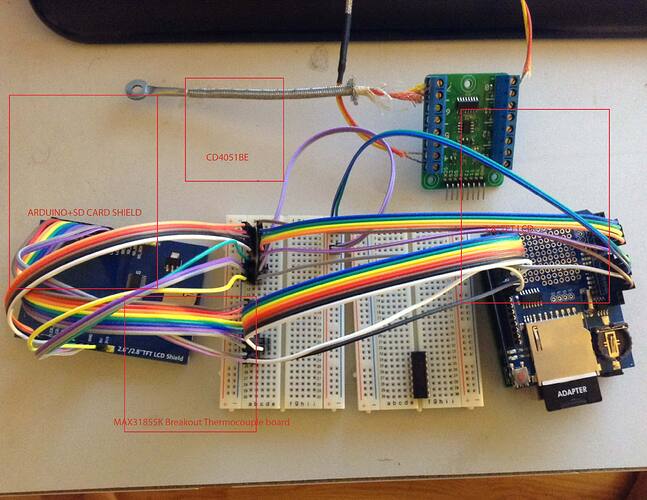When I first got the board , I asked myself the same question. But when I tested it, it worked fine. I calibrated the temperatures and it gave correct. Below is cpp file. this may answer your question.
// This library is derived from RocketScream.com's I2C MAX31855 library.
// Please support them from buying products from their web site.
// MAX31855/MAX31855.cpp at master · rocketscream/MAX31855 · GitHub
//
// This is a library for the MAX31855 thermocouple IC
//
// Look for the MAX31855 breakout boards on www.whizoo.com.
//
// Written by Peter Easton (www.whizoo.com)
// Released under WTFPL license
//
// Change History:
// 13 May 2014 Initial Version
#include "MAX31855.h"
MAX31855::MAX31855(int miso, int cs, int clk)
{
_miso = miso;
_cs = cs;
_clk = clk;
// MAX31855 data output pin
// Use internal pullup to be able to detect no connection to the MAX31855
pinMode(_miso, INPUT_PULLUP);
// MAX31855 chip select input pin
pinMode(_cs, OUTPUT);
// MAX31855 clock input pin
pinMode(_clk, OUTPUT);
// Default output pins state
digitalWrite(_cs, HIGH);
digitalWrite(_clk, LOW);
}
/*******************************************************************************
- Name: readThermocouple
- Description: Read the thermocouple temperature either in Degree Celsius or
- Fahrenheit. Internally, the conversion takes place in the
- background within 100 ms. Values are updated only when the CS
- line is high.
-
- Argument Description
- ========= ===========
-
- unit Unit of temperature required: CELSIUS or FAHRENHEIT
-
- Return Description
- ========= ===========
- temperature Temperature of the thermocouple either in Degree Celsius or
- Fahrenheit. If fault is detected, FAULT_OPEN, FAULT_SHORT_GND or
- FAULT_SHORT_VCC will be returned. These fault values are outside
- of the temperature range the MAX31855 is capable of.
*******************************************************************************/
double MAX31855::readThermocouple(unit_t unit)
{
unsigned long data;
double temperature;
// Initialize temperature
temperature = 0;
// Shift in 32-bit of data from MAX31855
data = readData();
// Is this a MAX31855? Bits 3 and 17 must be zero
if (data & 0x20008)
return NO_MAX31855;
// If fault is detected
if (data & 0x00010000)
{
// Check for fault type (3 LSB)
switch (data & 0x00000007)
{
// Open circuit
case 0x01:
temperature = FAULT_OPEN;
break;
// Thermocouple short to GND
case 0x02:
temperature = FAULT_SHORT_GND;
break;
// Thermocouple short to VCC
case 0x04:
temperature = FAULT_SHORT_VCC;
break;
}
}
// No fault detected
else
{
// Retrieve thermocouple temperature data and strip redundant data
data = data >> 18;
// Bit-14 is the sign
temperature = (data & 0x00001FFF);
// Check for negative temperature
if (data & 0x00002000)
{
// 2's complement operation
// Invert
data = ~data;
// Ensure operation involves lower 13-bit only
temperature = data & 0x00001FFF;
// Add 1 to obtain the positive number
temperature += 1;
// Make temperature negative
temperature *= -1;
}
// Convert to Degree Celsius
temperature *= 0.25;
// If temperature unit in Fahrenheit is desired
if (unit == FAHRENHEIT)
{
// Convert Degree Celsius to Fahrenheit
temperature = (temperature * 9.0/5.0)+ 32;
}
}
return (temperature);
}
/*******************************************************************************
- Name: readJunction
- Description: Read the thermocouple temperature either in Degree Celsius or
- Fahrenheit. Internally, the conversion takes place in the
- background within 100 ms. Values are updated only when the CS
- line is high.
-
- Argument Description
- ========= ===========
-
- unit Unit of temperature required: CELSIUS or FAHRENHEIT
-
- Return Description
- ========= ===========
- temperature Temperature of the cold junction either in Degree Celsius or
- Fahrenheit.
-
*******************************************************************************/
double MAX31855::readJunction(unit_t unit)
{
double temperature;
unsigned long data;
// Shift in 32-bit of data from MAX31855
data = readData();
// Is this a MAX31855? Bits 3 and 17 must be zero
if (data & 0x20008)
return NO_MAX31855;
// Strip fault data bits & reserved bit
data = data >> 4;
// Bit-12 is the sign
temperature = (data & 0x000007FF);
// Check for negative temperature
if (data & 0x00000800)
{
// 2's complement operation
// Invert
data = ~data;
// Ensure operation involves lower 11-bit only
temperature = data & 0x000007FF;
// Add 1 to obtain the positive number
temperature += 1;
// Make temperature negative
temperature *= -1;
}
// Convert to Degree Celsius
temperature *= 0.0625;
// If temperature unit in Fahrenheit is desired
if (unit == FAHRENHEIT)
{
// Convert Degree Celsius to Fahrenheit
temperature = (temperature * 9.0/5.0)+ 32;
}
// Return the temperature
return (temperature);
}
/*******************************************************************************
- Name: readData
- Description: Shift in 32-bit of data from MAX31855 chip. Minimum clock pulse
- width is 100 ns. No delay is required in this case.
-
- Argument Description
- ========= ===========
-
- NIL
-
- Return Description
- ========= ===========
- data 32-bit of data acquired from the MAX31855 chip.
-
*******************************************************************************/
unsigned long MAX31855::readData()
{
int bitCount;
unsigned long data;
// Clear data
data = 0;
// Select the MAX31855 chip
digitalWrite(_cs, LOW);
// Shift in 32-bit of data
for (bitCount = 31; bitCount >= 0; bitCount--)
{
digitalWrite(_clk, HIGH);
// If data bit is high
if (digitalRead(_miso))
{
// Need to type cast data type to unsigned long, else compiler will
// truncate to 16-bit
data |= ((unsigned long)1 << bitCount);
}
digitalWrite(_clk, LOW);
}
// Deselect MAX31855 chip
digitalWrite(_cs, HIGH);
return(data);
}
Contact GitHub API Training Shop Blog About
© 2016 GitHub, Inc. Terms Privacy Security Status



